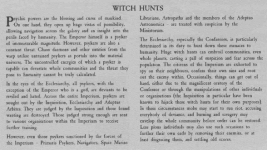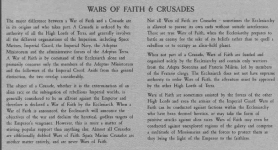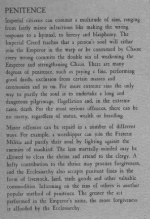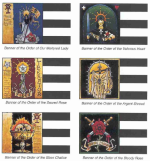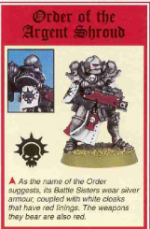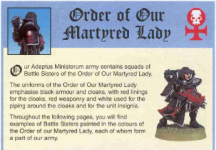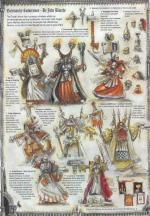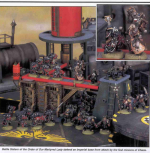Since the birth of humanity in the prehistory of Earth, the Emperor has protected and guided mankind. Down through the long millennia he has striven to thwart the enemies of the human race and protect mankind from its own self destructive instincts. He has constantly guarded the mass of humanity against dangers and foes it was not even aware existed. When ancient philosophers first speculated on the nature of the universe, the Emperor already knew the answers. When humanity took its first Jew tentative steps into space, he was aware of the perils that awaited them. When the nature of the warp was first discovered, he had already roamed its immaterial realm. The Emperor is the bastion upon which the human race is founded. Even in a deathly state, held immobile in the life-giving energies of the Golden Throne, the Emperor continues his eternal vigilance. Vast armies sweep through the galaxy in his name and whole planets are razed for his cause. His strength allows the starships of mankind to forge their way across the galaxy, encountering new stars, new worlds and new peoples. By his very presence the total and eternal damnation of Chaos is held in abeyance. Without him there is nothing.
THE HORUS HERESY
Even before his internment in the Golden Throne, the Emperor was worshipped as a god by many members of the Imperium, especially on the more regressive planets rediscovered during the Great Crusade. Primitive peoples spoke of gods descending from the skies in chariots winged with fire, and of beings who could smite down a foe with a mere glance. Of course, such fanciful descriptions could apply to almost any Imperial servant landing on a planet in a dropship, but the Emperor’s unique powers and presence meant that he was venerated as a living god wherever he passed. Then the tortuous storm of the Horus Heresy tore at the fabric of the Imperium. As humanity was embroiled in an apocalyptic civil war, the fate and future of mankind hung in the balance. If Horus were to triumph, humanity would be swept into the power of the dark Chaos Gods. In the end, while the followers of Horus assaulted the Imperial palace on Terra, the traitor Warmaster and the Emperor faced each other on the rebel Warmaster’s battle-barge. Their titanic conflict reflected the Heresy as a whole — a battle fought in the mind as well as with physical weapons. After a bitter struggle, the Emperor destroyed Horus but was fatally wounded himself. The Space Marine Primarch Rogal Dern discovered the Emperor’s devastated body, held alive only by the enormous power of his will. The Emperor was placed in stasis and the Adeptus Mechanicus constructed the Golden Throne to sustain his shattered form. As the Emperor’s body was incarcerated into the Throne and its life-giving properties flowed through his carcass, the Emperor’s great mind soared into the warp.
DESCENT INTO ANARCHY
Fuelled by the growing demands of the Cardinals, Ecclesiarchy tithes were increased once more. Unfortunately, much of the populace was already stretched to breaking point and this further increase was seen by many as unnecessarily exorbitant. Across many worlds of the Imperium the populace openly rebelled against the Ecclesiarchy and refused to pay. Even Planetary Governors spoke out against the excesses of the Ministorum, but they went unheeded. The Ecclesiarchy responded with a vengeance, sending its armies to crush any sign of revolt and executing higher officials as heretics. Alexis XXI used the Officio Assassinorum to eliminate several Governors who redirected their tithes to pay for their own Planetary Defence Forces, and is quoted as saying, “They had forsworn the Emperor's protection for their own worldly gains.” The tithes were used to build ever larger temples, to line the highways of planets with statues of past Ecclesiarchs and to decorate the Ecclesiarchal palaces with the rarest metals and gems.
The unrest continued, massive uprisings spreading across the Imperium, only for the Frateris Templars of the Ecclesiarchy to arrive and quell any insurgencies. All those who defied the rights of the Heclesiarchy were decried as heretics and suitably punished. Some thought the Ecclesiarchy’s bloody methods of control were excessive, but it was nothing compared to what was to come. Even as the Imperium struggled to survive amidst bushfire wars and a lack of true leadership from Earth, further disasters befell humanity. In the early 36th millennium the incidence of warp storms started increasing. Travel between all but the closest stars became risky, and as the centuries passed the warp soon became a tumultuous mass of roiling tempests and storms. Navigation became difficult everywhere and hundreds of systems were totally isolated. With the resources of the Administratum and Ecclesiarchy turned towards their power struggle, much of the Imperium devolved into anarchy. In those few worlds still accessible by starships, the power of the Ecclesiarchy was brutally enforced by the Frateris Templars and any slight deviation from the holy decrees was marked as heretical, with the burnings and hangings which attend that crime.
Seeing the turmoil wracking the Imperium, Chaos. raiders poured forth from the Eye of Terror to attack and despoil their ancient foes. Ork Warlords rampaged across vast tracts of the galaxy and there was nobody who could halt them. On the planets cut off from Terra, Chaos and Genestealer cults rose in rebellion and overthrew their governments, damning entire worlds to slavery and slaughter. Those worlds not overrun by alien attackers strove to retain what they could. As time passed even the most advanced worlds were brought to their knees. As before, with no central guidance from the Adeptus Ministorum even the worship of the Emperor began to devolve into a series of cults and sects, and in the trying times of those centuries those who were once brothers under the light of the Emperor fought against each other to assert their religious ideals. Much of the Imperium was under the malaise of a preapocalyptic gloom. Crazed zealots denounced the Ecclesiarchy and claimed the Emperor was displeased with their greed and excesses — sending the warp storms as a test to judge the truly faithful and set them apart from heretics and sinners. Spurred on by these statements, citizens turned to flagellation and self-mutilation to prove their belief and faith. Whole populations became seething masses of despair-laden cults, each trying to outdo the other in their torturous devotion to the Emperor. Strange splinter groups grew in power, preaching extreme causes. Bloodthirsty pogroms eradicated many innocents as the populace tried to stem the wrath of the God-Emperor. In some communities any small deviation from what was deemed normal brought instant death to a child and its family. Whole populations were enslaved or slaughtered, deemed heathens for some real or suspected deviancy.



